Flora and Fauna Living in Amami Oshima
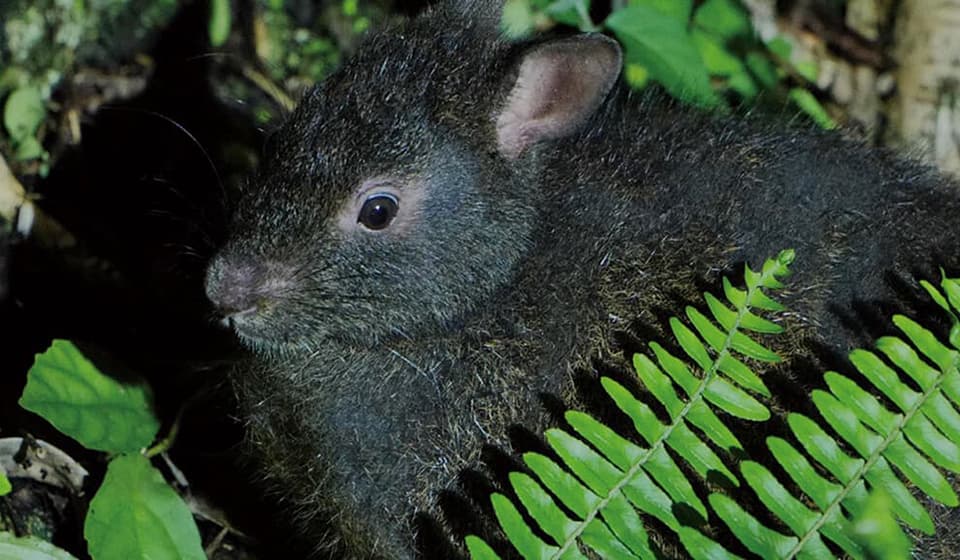
- TOP
- Flora and Fauna Living in Amami Oshima


Environment
The diverse habitats support abundant biodiversity
A variety of enviroments exist in Amami-Oshima, which is less than 0.5% of the area of Japan, due to the impact of topography and climate. A variety of creatures adapted to each enviroment where they nurture life.
A warm and humid climate of blessings
The subtropical oceanic climate of Amami-Oshima is warm and has a lot of precipitation throughout the year due to the influence of the Kuroshio Current and monsoons. It is a blessed environment for many plants and animals.
Annual rainfall
3,000mm on average
The annual rainfall in Tokyo is 1,600 mm.
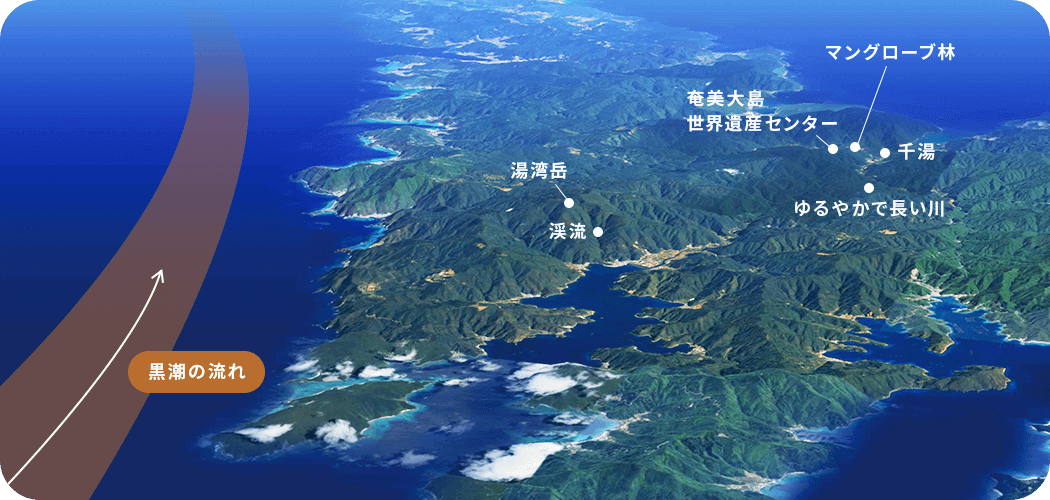
Complex terrain rich in undulations
“Small ridges and valleys formed by crustal movements are scattered. These make a moist environment of mountain streams and waterfalls all around. Sandy mud is deposited at the mouth of the river where a long and gentle river flows along tidal flats where mangrove forests grow.”
-
Annual sunshine duration
1,300hours on average
Saitama Prefecture, which is number one, has 2,300 hours.
-
Days with temperatures above 25°C
120days on average
It’s about twice as much as in Kagoshima City.
-
Annual average temperature
25°Cor higher
It is warm and humid throughout the four seasons.
creatures and plantsFlora and Fauna Living in Each Area
- The neighboring evergreen forests
- The aging forests
- The matured forests supported by large trees
- The Cloud Forest
- Mountain stream
- Mangrove
-
01The neighboring evergreen forests
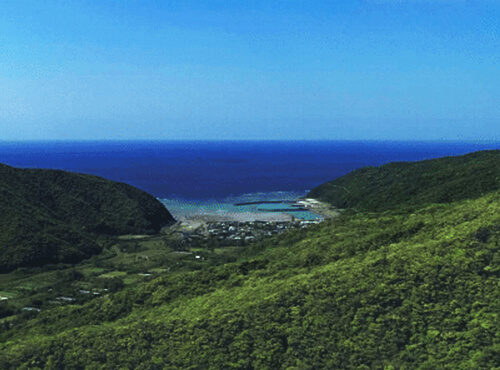
The growing forests are shimmering
Over 80% of Amami Oshima Island is covered in trees, most of which is secondary forest. After primeval forests were felled through forestry, castanopsis and other hardy plants sprouted, forming the forest as it is today. The forests surrounding the settlement, or shima, are bright, sunny forests that have grown over twenty years since the forest was felled. Old roads and charcoal kiln ruins remain in places, giving a glimpse into the relationship between humans and nature that has existed since antiquity. The castanopsis forests near human settlements are also teeming with plants and animals that take advantage of the sunlight here.
Featured Forest Flora and Fauna!
-

Habu viper
This snake can reach up to 2 meters in length. Its enormous size has made it an apex predator.
-

Amami jay
The Amami jay is 38 cm in length with a lapis-blue head, wings, and tail. It inhabits evergreen broad-leaved forests and villages.
-
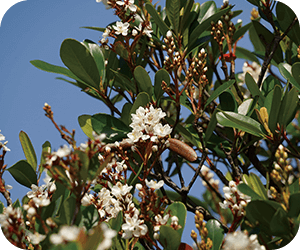
Rhaphiolepis indica var. umbellata
This evergreen shrub is distributed widely throughout Japan as well as East and Southeast Asia. In spring, flowers resembling plum blossoms bloom in high volume.
-
-
02The aging forests

A forest of luxuriant green leaves teeming with wildlife
Two to three decades after logging, secondary castanopsis forests reach their maximum height of roughly 15 meters, after which the trunk thickens and the lateral branches grow, the leaves luxuriating into a kind of umbrella. About thirty-five years after logging, the castanopsis leaves block the sunlight, making the forest dark and creating tiers containing many species, such as trees shorter than castanopsis, undergrowth, and the forest floor covered in fallen leaves.
Featured Forest Flora and Fauna!
-
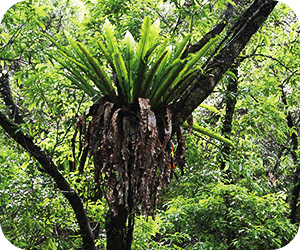
Asplenium nidus
A fern that grows on tree trunks in the Ryukyu Islands south of Yakushima. Large individuals can have leaves up to 2 meters in length.
-
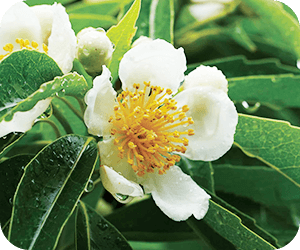
Iju camelia
An evergreen tree that is a subspecies of camellia. It produces large white flowers typical of the camellia family in early May.
-

Ryukyu scops owl
A subspecies of owl that inhabits a range from Amami Oshima to Yonaguni. It is 22 cm in length and has dark brown spots covering its entire body.
-
-
03The matured forests supported by large trees
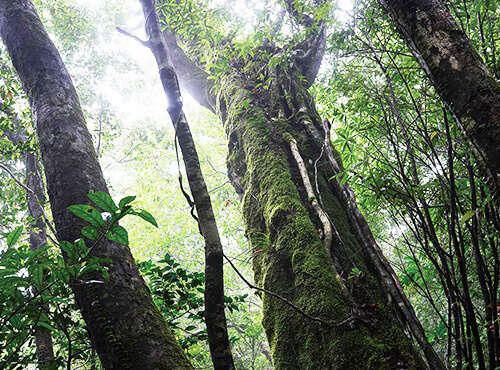
A forest that fosters myriad wildlife
20+ years after deforestation: In forests where more than fifty years have passed since deforestation, even larger castanopsis and other trees start to emerge. Its thick lateral branches branch even further, hollows form in the trunk, and great buttress roots develop as these trees take on new and various forms. It is thought that a forest takes more than one hundred years to return to a near pristine state after deforestation.
Featured Forest Flora and Fauna!
-

Castanopsis
A tree that epitomizes the forests of Amami. The flowers that bloom in spring emit a sweet fragrance that attracts all kinds of insects.
-
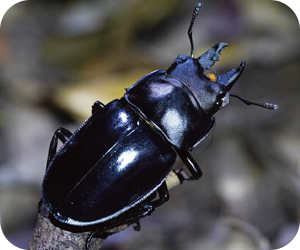
Amami stag beetle
They inhabit Amami-Oshima Island, Kakeroma Island, and Tokunoshima Island. Since they can only breed in large forests, their numbers and habitats have decreased due to large-scale logging, among other factors.
-
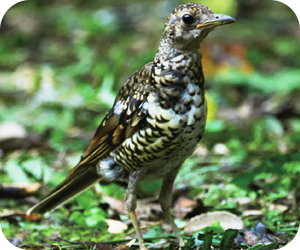
Otogisho Thrush
Endemic to Amami Oshima. During the breeding season from March to April, their beautiful singing of “kyoro-n, tsi” can be heard in the forest from early morning to dawn.
-
-
04The Cloud Forest
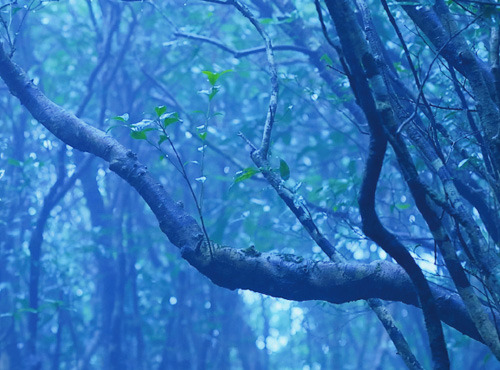
A Brisk Forest, Shrouded in Mist
Forests formed 500 meters above sea level in tropical and subtropical mountainous areas are called cloud forests, where fog and mist appear even on clear days, creating a humid environment with low sunlight. The Amami Oshima cloud forests are characterized short trees that can withstand the relatively low temperatures, strong winds, and poor nutritional conditions. With an abundance of ferns, orchids, mosses, and other species that thrive in damp environments, many plants endemic to Amami Oshima can be found growing on branches and rock walls here.
Featured Forest Flora and Fauna!
-
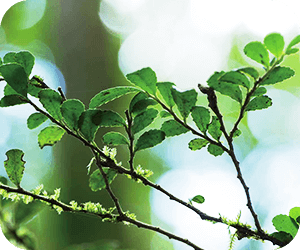
Eurya emarginata var. minutissima
An evergreen shrub and variant of the E. emarginata commonly found in coastal areas. The flowers of this species are a rare encounter.
-
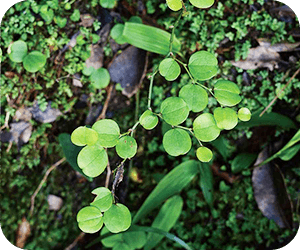
Smilax amamiana
A deciduous shrub belonging to the greenbrier family. This endemic species is found only near Mount Yuwan on Amami Oshima.
-
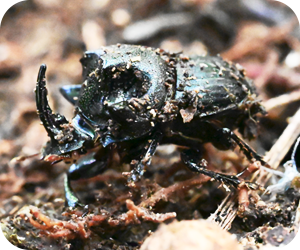
Maru-dai-koku-kogane
It is endemic to Amami Oshima and Tokunoshima. It feeds on the feces of animals such as Amami black rabbits. Its hind wings are atrophied and it cannot fly.
-
-
05Mountain stream
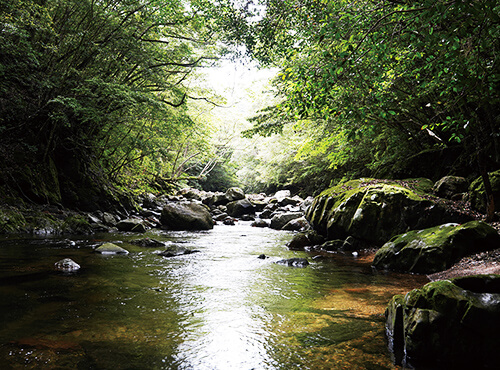
Life-nurturing, abundant water flow
On Amami Oshima, which has many steep terrains that stretch from the mountains to the sea, heavy rainfall has created numerous ridges and valleys by eroding the ground with water flow. In the upper and middle reaches of rivers that flow through these valleys, there are repeated fluctuations of water levels by 2-3 meters every time it rains. Plants have adapted to withstand the strong currents during floods and the dryness during droughts by having long and slender leaves or small leaves to reduce resistance against water flow, and by developing strong roots or rhizomes to cling to rocks or reducing hair on leaves to allow mud to dry more quickly. Additionally, Amami Oshima’s unique frogs and dragonflies can be seen around water sources.
Featured Forest Flora and Fauna!
-
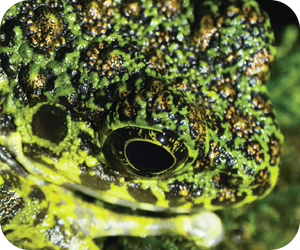
Amauima frog
Endemic to Amami Island. It is beautiful with golden spots on its green back. It calls with a clear, high-pitched voice during the breeding season from January to May.
-
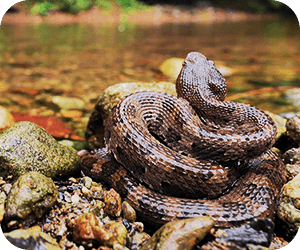
Hime habu viper
A venomous snake that inhabits riversides and forest floors ranging from the mountains to the plains. It is nocturnal and feeds primarily on frogs and small vertebrates.
-
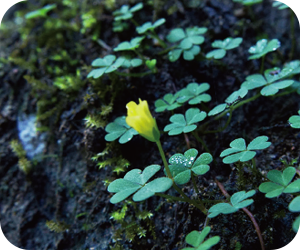
Amami Katabami
It grows by crawling on rocks along the mountain streams and blending into the moss. The plant body is very small, with leaves about 3-5 mm in size, and the flowers are also less than 1 cm.
-
-
06Mangrove

Connecting Mountain Water to Abundant Oceans for an Environment Teeming With Life
Mangrove is the collective term for distinctive plants inhabiting brackish waters where fresh water and sea water come together, such as tropical and subtropical estuaries. One of the largest mangrove forests in Japan has developed near the estuary where the Yakugachi and Sumiyo Rivers meet, where nutrients and soil flow in from the vast subtropical rainforest. The main constituent species of this mangrove forest are Kandelia obovate and oriental mangrove, mixed with the looking-glass tree and Excoecaria agallocha.Mangrove forests also serve as breeding grounds for fish such as Ryukyu Ayu, as well as the larvae of crustaceans and mollusks. The muddy wetlands of the intertidal zone are home to a diverse range of creatures including Southern mudskipper, Southern fiddler crab, sesarmid crabs, Yamamoto butterflyfish, Okinawa anajakko, and many others.
Featured Forest Flora and Fauna!
-

Soldier crab
This species inhabits the Nansei Islands. This crab can move forward and can often be found in tidal flats, spinning as it burrows beneath the sand.
-

Oriental mangrove
An evergreen tree and one of the constituent species of the mangrove. A characteristic of this tree is that its fruit germinates and grows on the tree before falling.
-

Ryukyu Ayu
It lived in Amami Oshima and Okinawa Island, but became extinct in Okinawa Island in the 1970s. It spawns on the riverbed in winter, and the young fish live along the coast of the sea, and migrate upstream again in spring.
-

Month
The forest wildlife calendar
“The subtropical maritime climate of Amami Oshima Island is temperate throughout the four seasons. Here, we present flora and fauna adapted to each season of this temperate climate based on a seasonal almanac.”
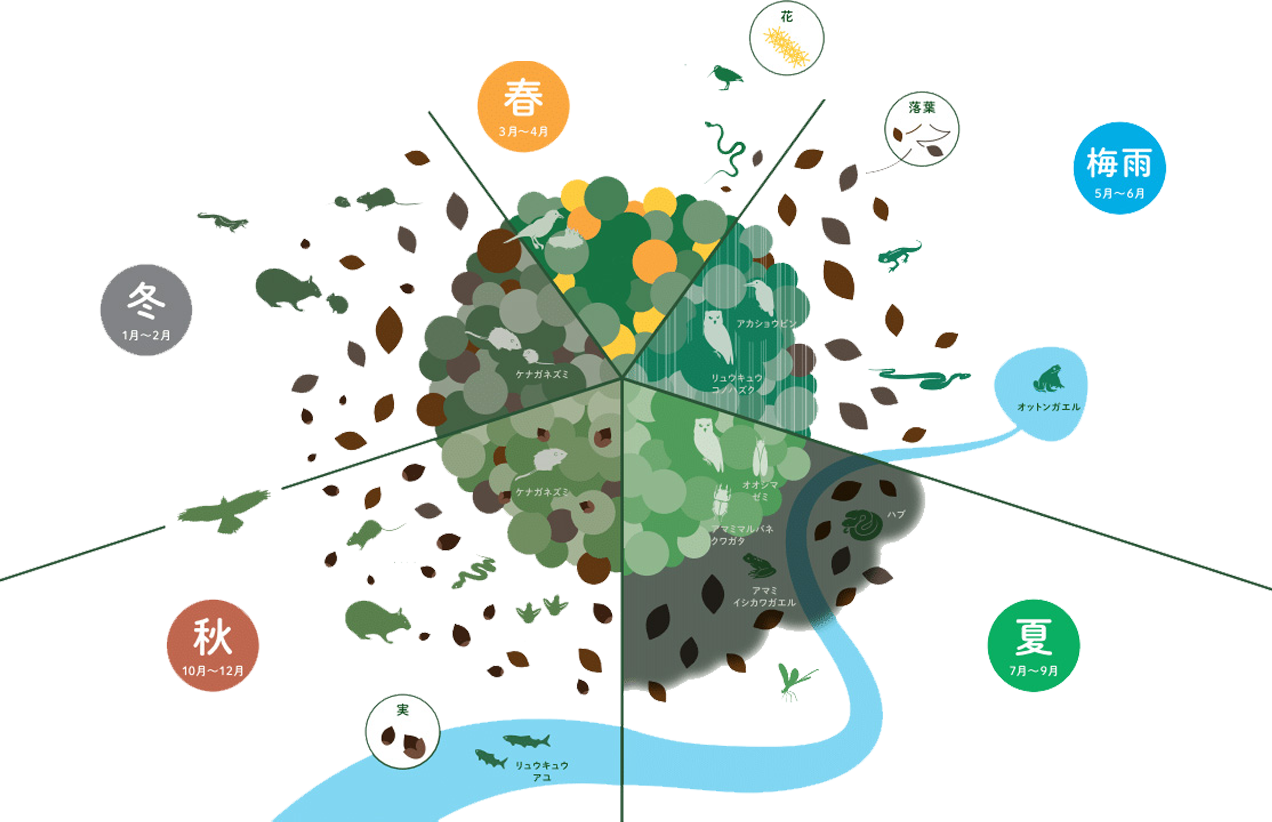
-

The season when the leaves of the Castanopsis fall and the yellow flowers bloom. Insects attracted by the smell of flowers and birds that feed on them gather.
-

The rains increase the amount of water in streams and rivers. Water gets stored in fallen and composted leaves.
-

The forest protects the wildlife from strong sunlight and typhoons.
-

Acorns of the Castanopsis are an important source of food for the animals in the forest. Mammals enter the breeding season.
-

As the habu viper is less active, mammals enter the parenting season. Newborns grow up by eating acorns.。

Hub
A unique ecosystem topped by the hub viper
A lack of carnivores and large raptors in the ecosystems of Amami Oshima, Tokunoshima, and northern Okinawa Island in central Ryukyu has made the Ryukyu odd-tooth snake and the hub viper, which can grow as large as 2 meters in length, the largest snakes in their respective genera and the apex predators within the ecosystem.
The Amami rabbit (endemic to Amami Oshima and Tokunoshima) and three species of the spiny rat genus (endemic to Amami Oshima, Tokunoshima, and northern Okinawa Island) are nocturnal land creatures, meaning they are at high risk of predation by hub vipers; however, they have evolved behaviors to avoid this danger.
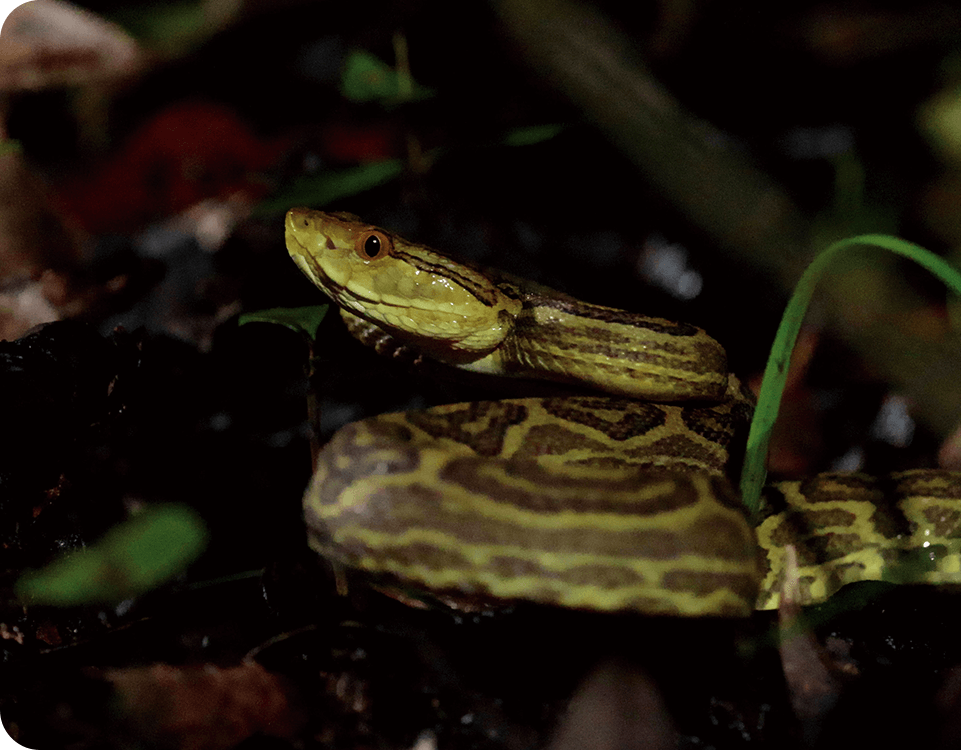
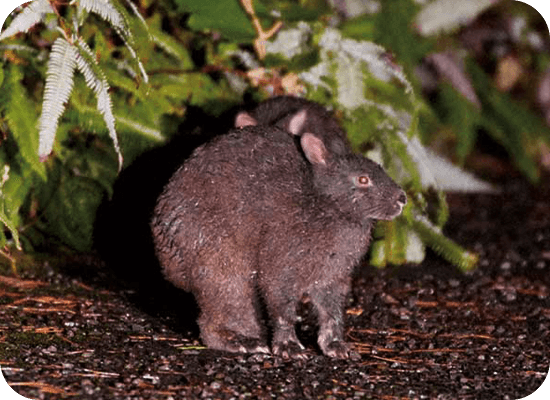
The Amami rabbit, for example, digs birthing burrows on steep slopes, and forages and defecates in sunken areas or riverbanks, where it has a broad view of its surroundings. Spiny rats, meanwhile, can leap vertically about 50 cm to dodge the hub viper’s attack. Thanks to this ability, the spiny rat is rarely included in the hub viper’s prey. Meanwhile, the Ryukyu odd-tooth snake, which, like the hub viper, is nocturnal, rarely preys on mammals, like other species of the genus Dinodon, but its stomach contents often include birds and other reptiles, including the hub viper. Moreover, this snake exhibits a special behavior of feeding on the hatchlings and eggs of sea turtles that have come ashore to lay eggs, a behavior extremely rare among snakes that plays a part in the food chain and circle of life unique to the islands.





